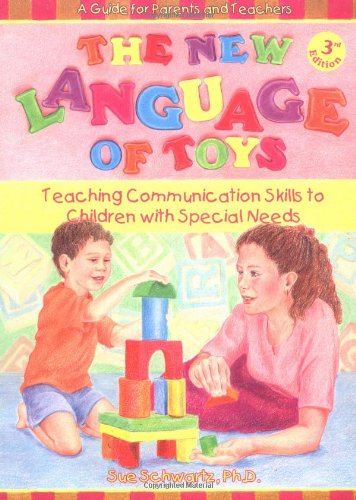All books / Book
The New Language of Toys: Teaching Communication Skills to Children With Special Needs, a Guide for Parents and Teachers

| Full title: | The New Language of Toys: Teaching Communication Skills to Children With Special Needs, a Guide for Parents and Teachers |
|---|---|
| ISBN: | 9781890627485 |
| ISBN 10: | 1890627488 |
| Authors: | Sue Schwartz |
| Publisher: | Woodbine House |
| Edition: | 3rd |
| Num. pages: | 249 |
| Binding: | Paperback |
| Language: | en |
| Published on: | 2004 |
Read the reviews and/or buy it on Amazon.com
Synopsis
The guide that thousands of parents and professionals depend on for fun and constructive ways to stimulate language development in young children with special needs is newly revised and updated. The New Language of Toys, third edition, features all new toys (more than 60) and toy dialogs -- brief conversations during play -- appropriate from birth through age six. New photographs show specific toys that families may already own or can easily purchase, as well as others that they can make at home. Chapters on using computers and multimedia are expanded and now include websites for finding the most up-to-date information. The extensive resource section lists dozens of toy companies, related books, and helpful organizations, making this a thoroughly practical and worthwhile book.
Doody Review Services
Reviewer:Catherine Baer Coleman, M.S.(George Washington University)
Description:This third edition of this book is updated to include newer toys and their uses in facilitating effective play techniques. It is mainly designed for parents/caregivers as they are the child's first teachers, according to the author. However, the book has been widely used by speech-language pathologists, early interventionists, special educators and students in any of those fields.
Purpose:The purpose is to educate parents on the variety of functional useful toys and how each can stimulate language in many ways. This edition includes new toys and has expanded the technology chapters to meet the changes and growth in the use of technology to further language development. The book clearly meets its objectives as did the first and second editions. It is a long-standing reference for families and practitioners.
Audience:The book is written mainly for families as a way to understand the framework of language development and how play is the best early stimulating experience for children with and without communicative handicaps. The book is also a superb reference tool for graduate students who are just beginning to understand and implement the fine art of structured play therapy.
Features:The three parts cover language development, recommended toys and their use, and how toys can be used for learning. This will assist parents in making wise toy purchases or in using current toys in varied ways. The book is clearly written for parents with colorful pictures and language dialogue to aid the parents' interactions with their child. The seven appendixes, which include a materials list and toy manufacturers, are a helpful addition for parents and practitioners. The toy sections are clearly delineated and easy to read.
Assessment:The book is different than other materials which are generally geared toward the practitioners in the field. It is useful that this book is written mainly for parents and is a nice tool to offer to parents to aid the therapeutic process and relationship. Parents can not only observe the practitioner implementing play therapy but can have an informative book to further educate themselves on language development and intervention techniques.